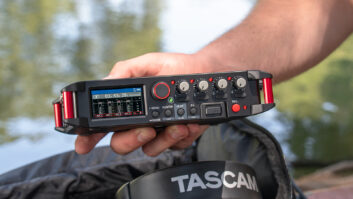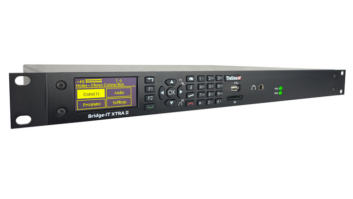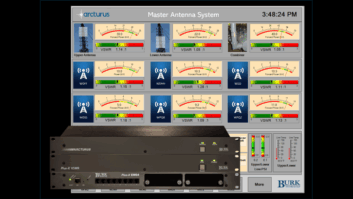Behringer’s latest, the Eurorack MXB1002, is a 10-channel console featuring five microphone preamps, sliders (no knobs!) for faders, and can run on battery power.
The MXB1002 does not match the flexibility and sound quality of other mini mixers at three times the cost. But the price/performance ratio is terrific. Those looking to do radio work will be pleasantly surprised by the value of this Behringer device.
Tiny footprint
At 11.7 inches by 8.5 inches, the footprint of the MXB1002 is about the same as a standard sheet of paper, albeit almost three inches high at the thickest and weighing in at about 5 pounds. Except for the external power supply connector and the on/off button, all connectors/controls are located on the top.
(click thumbnail)Behringer’s Eurorack MXB1002,
From the left, the first two channel strips are mono and the remaining three are stereo. Each comes with a gold-plated XLR connector. The mono channels also have a balanced 1/4-inch line input jack and an insert jack; the stereo channels have L/R balanced 1/4-inch jacks that can be used in parallel with the microphone input.
Each channel has a three-band EQ, pan, gain and FX level controls. A separate stereo tape channel gives another two channels of I/O and offers both 1/4-inch and RCA connectors. Besides the headphone and main output, monitor send and FX send 1/4-inch jacks complete the I/O layout.
The sealed faders, five-level LED meter, phantom power switch and monitor/FX and headphone levels fill out the rest of the board’s real estate. It is laid out in a straightforward way.
For the most part, construction quality was excellent. The sliders and pots were solidly built and had a good feel – amazing for the price (less than $150).
We started by turning up all the pots to max and see how much noise there was with nothing attached.
Product CapsuleThumbs Up
Inexpensive quality
Lots of microphone inputs
Sliders, not knobs
Thumbs Down
Phantom power drops and LED levels shut off in battery operation
No dual monitor outs
Runs on 9V batteries
Price: $150
For more information contact Behringer in Ohio at (425) 672-0816, e-mail [email protected] or visit www.behringer.com
Recording with Cool Edit Pro 2.0 through a Digital Audio Labs CardDeluxe, the hiss was enough to light up the first LED on the meter and Cool Edit’s analysis gave about a 46 dB signal-to-noise ratio. Fortunately, that dropped drastically to reflect the published specs of about 96 dB when everything was dropped down to a more reasonable (i.e. mid) range.
Taken alone, the microphone preamps are rated at a respectable 104 dB. At that point, it was hard to pick out the noise from the preamps from other possible sources.
My point
The real point of the “pump-up-the-volume” test was to see how susceptible the board is to RF and the like.
Given the amount of noise floating around PC-based studios, this can be problematic. Even using balanced connectors does not help when the circuits inside the board are not wired correctly.
The MXB1002 seems to be properly shielded and did not act like an antenna picking up noise from my production computer. It does not suffer from such shortcomings and is up to snuff in the production studio. Despite the low price, this is not a toy.
This board uses the same 17-volt power brick as that on the Micromixer in the line, the MX 602A. The bonus with the MXB1002 is the ability to run off of batteries. The battery slot on the bottom closes with a Phillips-head screw.
Inside, the workmanship seems sloppy compared to the fit and finish of the rest of the unit. But once in, the batteries do not bounce around.
The major issue is the battery power this unit consumes. For those of us addicted to using rechargeable batteries, 9V is a tough choice. The biggest problem is hunting down a charger for 9V NiMH type cells. My “AA” setup does not include the requisite connectors.
My tests were done with the recommended Duracell alkaline cells. Of course, getting the proper voltage from AA batteries would require 12 or more. So this may be the best choice given the size of the board.
Switching to battery shuts off the LED showing levels. Also, the 48-volt phantom power drops to 18 volt only. Depending on what microphones you are using, this could be problematic. Despite these energy-saving measures, a set of batteries lasted slightly less than official specs – just under four hours. For extended projects, keep a few extra sets of 9V alkaline batteries around.
The multitude of inputs on this unit seem to come at the price of more outputs. For just a strait stereo out, that’s not a problem. But I did wonder about the lack of dual balanced control room jacks in addition to the main outs.
Instead, there is a single (unbalanced stereo) monitor send. So setting the mixer up in a project studio means feeding the mains into the production computer, and sending the control room jack to monitors through a “Y” cable.
I don’t know why Behringer included the added amenity of 1/4-inch and RCA tape-ins and cut the dual monitors of its other entry-level boards.
The MXB1002 is handy and well-built; it sounds exceptional. It is suitable for those doing fieldwork on tight budgets.
Note: In an upcoming issue of Radio World, Alan R. Peterson will evaluate the larger Behringer DDX3216 mixer.








